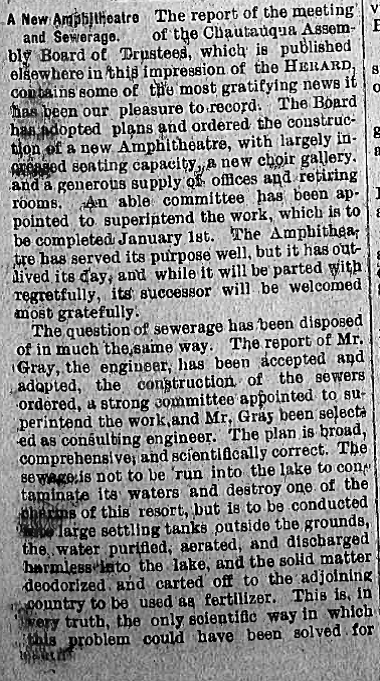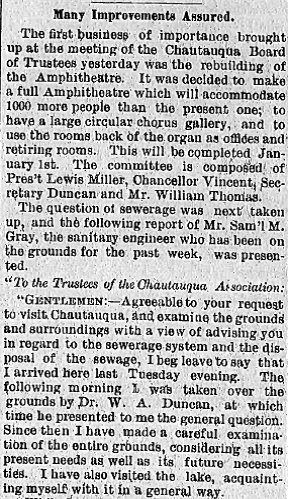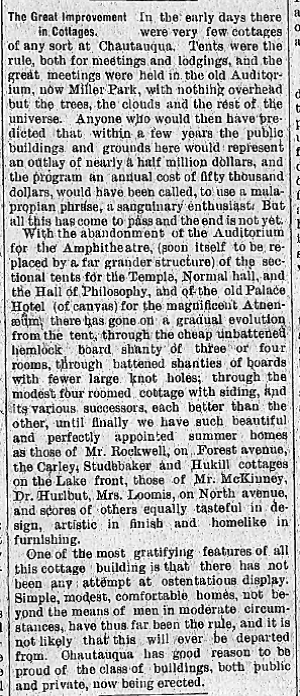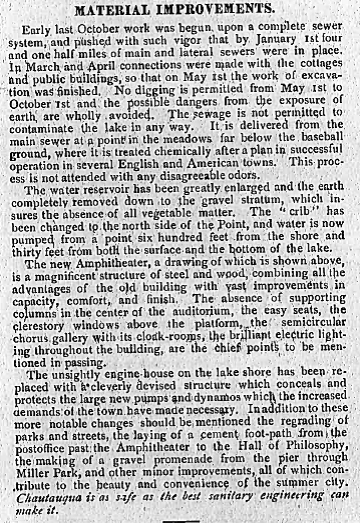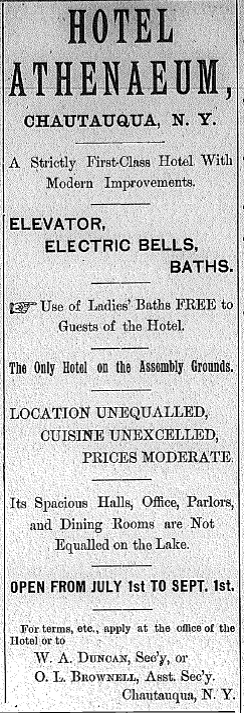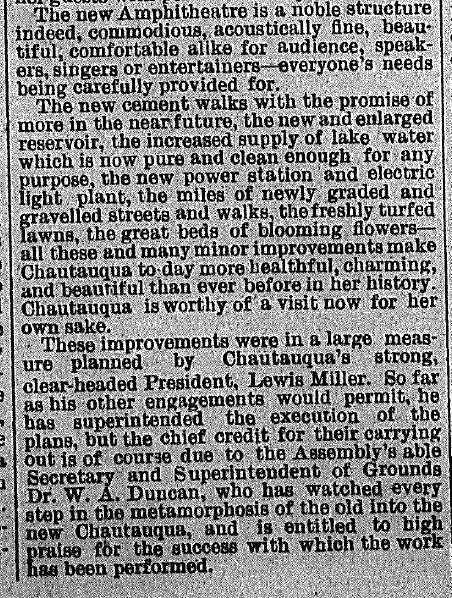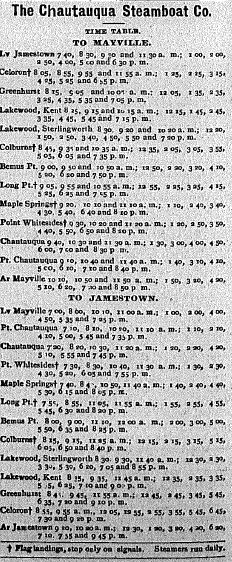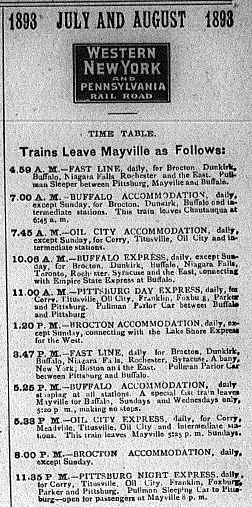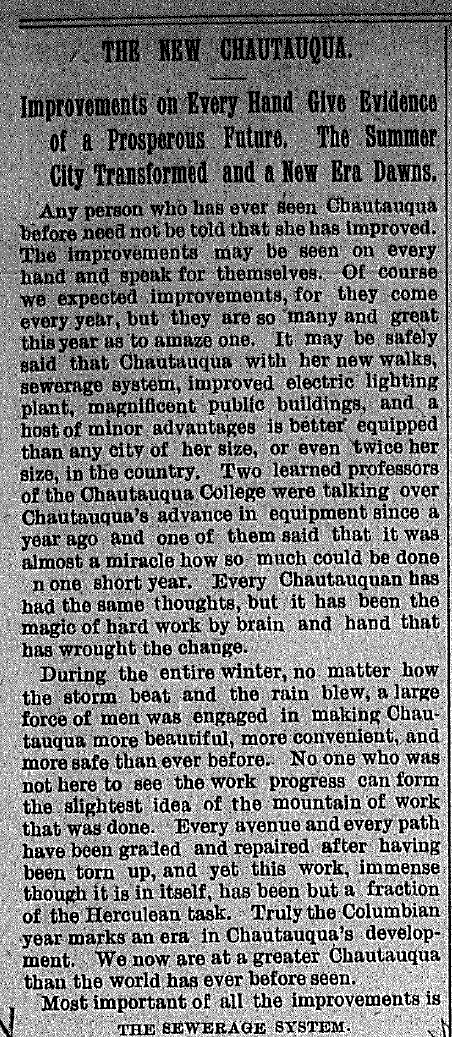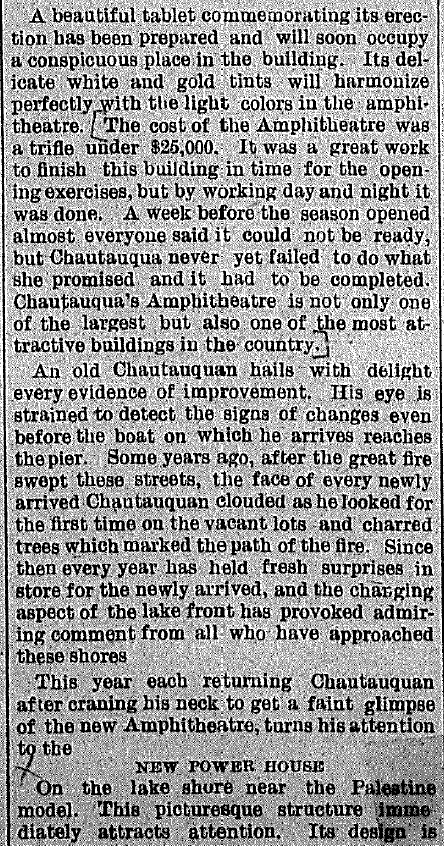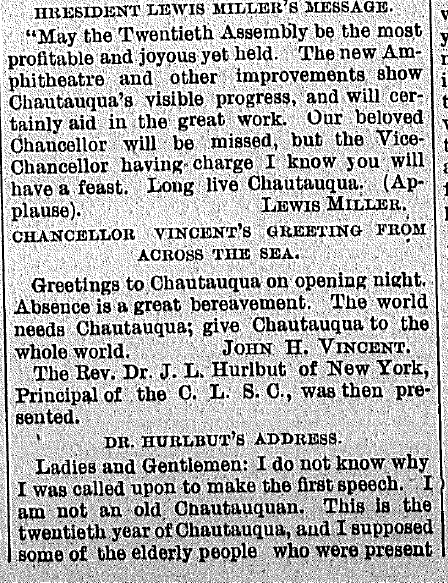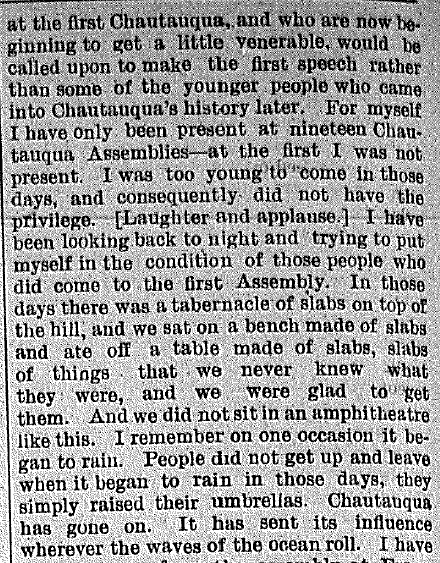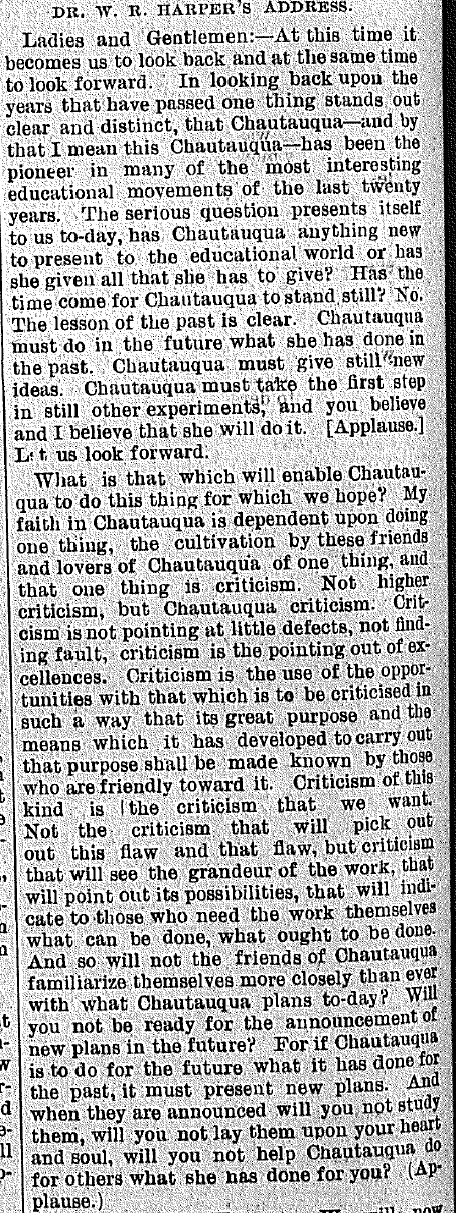Well since you’ve come this far you can see where I got the name and tagline for this blog site in the Assembly Herald banner above. Four cents was the price for all the news that fit in the eight pages they print. The cost of a season gate pass was $5.00 and a week at the Athenaeum (American plan from the beginning) ranged from $15-$25.00 if your keeping score at home. I have clipped article quotes from the 1892-93′ editions of the Chautauqua Assembly Herald about Chautauqua’s bold decisions to build a New Amp, Sewer system, and other major improvements. They further describe the incredible and accelerating evolution occurring in Chautauqua at the time. I have pulled out the most appropriate quotes in italics and center blocked them above each article clipping for those who don’t want to read the whole thing. I thank you for your support…of our sponsors, in advance.
“It was the best of times, it was the worst of times, it was the age of wisdom, it was the age of foolishness…it was the season of Light, it was the season of Darkness…in short, the period was so far like the present period, that some of its noisiest authorities insisted on its being received, for good or for evil, in the superlative degree of comparison only.”
– A TALE OF TWO CITIES by Charles Dickens
Meanwhile, back in Versailles, the monarchy and the royal court were accused of being isolated from, and indifferent to the escalating crisis. The Enlightenment had produced many writers, pamphleteers and publishers who could inform or inflame public opinion depending on their choice of words. The opposition used this resource to mobilize public opinion against the French monarchy.
The hindsight of looking back in history and making comparisons sometimes allows for greater context, better perception, and a more thorough understanding of current events. While some of the language swirling around the Amp uprising may somewhat resemble the French Revolution, the situation isn’t as dire. But there is little doubt that, like the weather, things are starting to heat up. Unfortunately the various aspirations and resentments of of a wide variety of constituents has cast this whole New Amp project into a negative character debate. So I guess that makes the Gadfly, the Voices, the committee, and yours truly, the Four Pamphleteers (amongst others). So this Pamphleteer is throwing it back to 103 years after the aforementioned revolution and further exploring “for good or for evil, in the superlative degree of comparison,” Chautauqua then and now.
Chautauqua finds itself in a similar situation today, as it was between the 1892 & 1893 Seasons. The Amphitheatre, despite just being 14 seasons old is already showing signs of age and it’s clear that it can’t keep pace with the growth of Roger’s Band, other performances, and the growing Assembly in general. The flat roof is leaking and causes a deafening noise during rain storms, and there is ongoing concern about the winter snow loads. The numerous columns cause many seats to have obstructed views while the oil lamps are a fire hazard. There had been talk of renovating the Amphitheatre after the 1891 season, but the cost was as great as that of building a new Amphitheatre. The board tabled that decision until the summer of 1892 as they wanted to ensure that previously incurred debt (primarily the building of the Athenaeum) was paid off first. In anticipation of that, during the summer of 1892 the Board had shown tremendous fortitude and foresight by approving over $100,000 in new construction projects slated to be completed before the 1893 Assembly begins. With Chautauqua on firm financial footing the rebuilding of the Amphitheatre and the installation of a new Sewer system topped an extensive and incredibly ambitious list.
 Rogers Band on the Platform and in the Choir Gallery of the New Amp
Rogers Band on the Platform and in the Choir Gallery of the New Amp
I did the home work, reading every issue of the Assembly Herald from 1892-93′ and surprisingly enough there was no mention of a “Save the Amp” campaign. I guess “sanguinary enthusiastic” Chautauquans (if there were any) at the time, realized that the old Amp had indeed outlived it’s day and Chautauqua needed and deserved a new one. Ada Louise Huxtable, Pulitzer Prize winning architecture critic for the NY Times wrote in her October 30, 1963 editorial, “Farewell to Penn Station”, “Any city gets what it admires, will pay for, and, ultimately, deserves.” She of course was lamenting the loss of Penn Station but that literary sword cuts both ways and across time. Chautauqua, by virtue of an unprecedented fundraising effort and corresponding outpouring of philanthropic support by generations of Chautauquans has raised $30 Million to pay for the New Amp, which is much needed, richly deserved, and those efforts should be greatly admired.
The next three articles are from the 1892 Assembly Herald and detail the decisions by the Board of Trustees to proceed with the planned improvements between the 1892 & 1893 seasons. Private investment in more new cottages being built than ever before also signals a growing confidence in Chautauqua by Chautauquans as the public buildings and private cottages accelerate their evolution heading into the 20th century.
1892 Chautauqua Assembly Herald
The Assembly Herald editor Dr. Flood writes:
“The Board has adopted plans and ordered the construction of new Amphitheatre, with largely increased seating capacity, a new choir gallery, and a generous supply of offices and retiring rooms. An able committee has been appointed to superintend the work.
“The Amphitheatre has served its purpose well, but it has outlived its day, and while it will be parted with regretfully its successor will be welcomed most gratefully. The question of sewerage has been disposed of in much the same way.”
“The first business of importance brought up at the meeting of the Chautauqua Board of Trustees yesterday was the rebuilding of the Amphitheatre. It was decided to make a full Amphitheatre which will accommodate 1000 more people than the present one; to have a large circular chorus gallery, and to use the rooms back of the organ as offices and retiring rooms.”
Later that Summer they wrote of the abandonment of the Auditorium in Miller Park for the 1879 Amphitheatre, and that being replaced by the planned 1893 Amphitheatre and of Chautauqua’s ongoing evolution from tents to well appointed cottages and public structures:
The Great Improvement in Cottages.
“In the early days there were few cottages of any sort at Chautauqua. Tents were the rule, both for meetings and lodgings, and the great meetings were held in the old Auditorium, now Miller Park, with nothing overhead but the trees, the clouds and the rest of the universe. Anyone who would have then predicted that within a few years the public buildings and grounds here would represent an outlay of nearly half a million dollars, and the program an annual cost of fifty thousand dollars, would have been called a sanguinary enthusiast. But all this has come to pass and the end is not yet. With the abandonment of the Auditorium for the Amphitheatre, (soon itself to be replaced by a far grander structure) of the sectional tents for the Temple, Normal Hall, and the Hall of Philosophy, and of the old Palace Hotel (of canvas) for the magnificent Athenaeum, there has gone on a gradual evolution from the tent, through the cheap unbattened hemlock board shanty… through battened shanties of boards with fewer large knot holes; through the modest four roomed cottage with siding, and its various successors, each better than the other…Chautauqua has good reason to be proud of the class of buildings both public and private, now being erected.”
The Board meeting held in Pittsburg (before the h was added) in mid January 1893 was described as one of the most important ever held. In hindsight, this would prove to be a huge understatement when combined with the decisions already made in the Summer of 1892, and in light of upcoming events in early 1893. At the time their biggest worry was the possible competition from the World’s Fair in Chicago adversely affecting attendance at the upcoming summers Assembly.
“The welcome announcement was made that the debt of Chautauqua had all been paid. The Board, however, had anticipated this happy condition and had already at former meetings authorized improvements of greater importance and cost which had been waiting for the time when the indebtedness incurred for those already made should have been paid. The completion of some of these improvements, and the certainty that all would be completed for the opening of the present season, was there announced.”
Within weeks of this Board meeting the United States began tipping into the Panic of 1893, one of the worst recessions this country has ever seen. Stock prices declined, unemployment spiked, and there was a run on gold as banks and businesses failed. Construction loans and other forms of lending ground to a halt. Chautauqua, fortuitously was already well underway with an unprecedented amount of both, public and private construction projects.
As the following articles show us, it absolutely was, in many ways the best of times for Chautauqua. Meanwhile, just outside the gates it was the worst of times for the rest of the country as the Panic of 1893 was wrecking havoc on the nations economy.
1893 Chautauqua Assembly Herald – Issue #1 – July 22, 1893
Chautauqua builds a brand new Amphitheatre for the 1893 Assembly. They also installed a brand new Sewerage system which got much more coverage than the Amp in the advance issue that came out in June and the first edition in July. But what gets the most coverage in each and every edition of the Assembly Herald is the Program. The speakers lectures are “reported stenographically” in every issue. The new Amp almost seems to be an afterthought as all the attention is focused on what happens on the platform, in the hall in the grove, and in the classes. The ongoing evolution of Chautauqua’s buildings and cottages is remarkable. It’s refereed to as The New Chautauqua!
 Artist Rendering of the New Amphitheater
Artist Rendering of the New Amphitheater
MATERIAL IMPROVEMENTS
“The new Amphitheater, a drawing of which is shown above, is a magnificent structure of steel and wood, combining all the advantages of the old building with vast improvements in capacity, comfort, and finish. The absence of supporting columns in the center of the auditorium, the easy seats, the clerestory windows above the platform, the semicircular chorus gallery with its cloak rooms, the brilliant electric lighting throughout the building, are the chief points to be mentioned in passing.”
The New Chautauqua
“Since a year ago Chautauqua has so completely changed, that it is not inappropriate to christen it the “New Chautauqua” The improvements made since the close of the Assembly of 1892…are of a most remarkable character. They have been planned with a far-sighted ability and the plans carried out with discretion, wisdom and liberality. They touch Chautauqua life at every point. They have to do with the health, the comfort and the pleasure of all who come here, whether to amuse and instruct others, or to be amused, entertained, or instructed by others. The outside world marvels at the courage of the governing body – The Board of Trustees – who, with a World’s Fair staring them in the face, yet ordered for this season over one-hundred thousand dollars of improvements”
At the beginning of the 1893 Assembly, after all the work which I detail below was completed, it is reported that the courage shown by the Board of Trustees was marveled at by the outside world. Today some might call them…”Rock Stars,” because they absolutely crushed it. Hitting it on the screws, and out of the park. So then, why, in the face of Chautauqua’s equally ambitious and successful efforts to carefully plan and raise money for a New Amp are the Administration and the Board of Trustees being miscast by an overly vocal minority, as a misguided, isolated monarchy and royal court? Yes, they started the process thinking Rehab, but it became painfully obvious that was not the best path to follow, so they continued to move forward, not back, and arrived at the only practical conclusion, given the existing conditions and circumstances. The due diligence, after a reality check, was completed appropriately, and once again, rebuilding the Amp is the best solution.
Dr. Flood leads off his description of the “New Chautauqua” improvements with commentary on the New Amp and seven miles of sewerage system. He also describes the contribution of Dr. Duncan, the able Secretary and Superintendent who oversaw all the work.
“The new Amphitheatre is a noble structure indeed, commodious, acoustically fine, beautiful, comfortable alike for audience, speakers, singers or entertainers-everyone’s needs being carefully provided for…The sewerage system…seven miles in length…is the first complete system of the kind ever built on the American Continent.”
Editors Note: Have a look at the timetables for the Steamboats and Trains. Kind of puts the C.A.R.T.S. Chautauqua schedule in a not so flattering light.
From the July 22, 1893 first edition of the Assembly Herald Dr. Flood writes :
THE NEW CHAUTAUQUA
Improvements on Every Hand Give Evidence of a Prosperous Future. The Summer City Transformed and a New Era Dawns
“Any person who has ever seen Chautauqua before need not be told she has improved. The improvements may be seen on every hand and speak for themselves. Of course we expected improvements, for they come every year, but they are so many and great this year as to amaze one. It may be safely said that Chautauqua with her new walks, sewerage system, improved electric lighting plant, magnificent public buildings, and a host of minor advantages is better equipped than any city of her size…We are now a greater Chautauqua than the world has ever seen.”
And for those of you concerned about the timetable for the completion of the New Amp, this comparison is for you.
“Two learned professors of the Chautauqua College were talking over Chautauqua’s advance in equipment since a year ago and one of them said it was almost a miracle how so much could be done in one short year. Every Chautauquan has had the same thoughts, but it has been the hard work by brain and hand that has wrought the change. During the entire winter no matter how the storm beat and the rain blew, a large force of men was engaged in making Chautauqua more beautiful, more convenient, and more safe than ever before. No one who was not here to see the work progress can form the slightest idea of the mountain of work that was done.”
Here’s a complete reckoning of the major projects that were finished between the 1892 & 1893 Chautauqua Assembly’s, that totaled over $100,000 in public improvements to the grounds.
1 – Demolition of the Original Amp and Benches and removing all the debris.
2 – Rebuilding a New Bigger & Better Amp and all new Benches.
3 – Excavation and installation of seven (7) miles of Sewer lines at a depth of 16′ below grade. The scope of work also included 140 manhole covers, new water main lines, and fire hydrants.
4 – A new Disposal Works Building was erected below the ball-field, where the sewerage system terminated, completing the system.
5 – Three (3) miles of brand new cement Sidewalks were installed by contractors brought in from Ohio.
5 – A new and larger Reservoir was excavated and built to better serve the growing Assembly.
6 – New Street Lighting was installed.
Imagine that! Just for a moment take yourself back to that off season and try to visualize what it was like with the Amp being knocked down and a larger improved model being built in its place. Every street and sidewalk being torn up and seven (7) miles of 16′ deep trenches dug down the center as they laid new sewer pipe, placed water mains, 140 man holes and fire hydrants throughout the grounds, terminating in a new sewage plant being built at the same time. When the sewer was completed they framed and poured out three (3) miles of new cement sidewalks. Chautauqua had never seen anything like it, nor will she ever again.
In addition, 43 new cottages were built as the public and private investments in Chautauqua reached a critical mass and tipping point. This incredible off season of work launches Chautauqua towards the 20th Century with unstoppable momentum.
So at the considered risk of once again being labeled reckless and superficial, I submit the following for your review. I still absolutely maintain, that if Chautauqua can complete all those improvements in one off season with the construction tools, methods and technologies available to them in 1892, then for goodness sake, they can certainly knock down that little old Amp and rebuild a bigger, better version in one off season. It is, as the founding fathers demonstrated, as simple as marshaling the required human and mechanical resources necessary to complete the job. Chautauqua has been there, and done more than that already.
Editors Note: In addition to the larger scale improvements occurring, the Mason & Hamlin Piano Co. had secured the exclusive Piano rights in Chautauqua and had built the sixth and seventh practice shacks between 1892 & 93′ as part of a long term contract to provide two shacks per year. And now you know the rest of that story.
“Scarcely second to the sewerage system is the New Amphitheatre. When the old Amphitheatre was built it was considered a tremendous work, but the new structure is a greater improvement on the old than the old Amphitheatre was on the old Auditorium in Miller Park.”
“The lower floor opening on the ravine has a large reception and waiting room for the Assembly’s guests. On the right of this room are the offices of the Department of Instruction and a retiring room for speakers. On the left of the reception hall are retiring rooms for solo singers. All the offices and rooms are connected by electric bells and speaking tubes. Just to the left of the organ is a large room devoted to the chorus.”
“Deserving of special mention are the broad, well lighted passage ways which connect the stage, besides the broad stage itself. The electric lights encircling the rim of the entire roof and arching the platform, the colored lights back of the choir gallery and the many arc lights render it doubly attractive at night…Numerous other features of this unique structure might be mentioned, but no description can adequately picture it to the mind. It is indeed a remarkable structure. As there are no microbes in our water so there are no diptera in our Amphitheatre.”
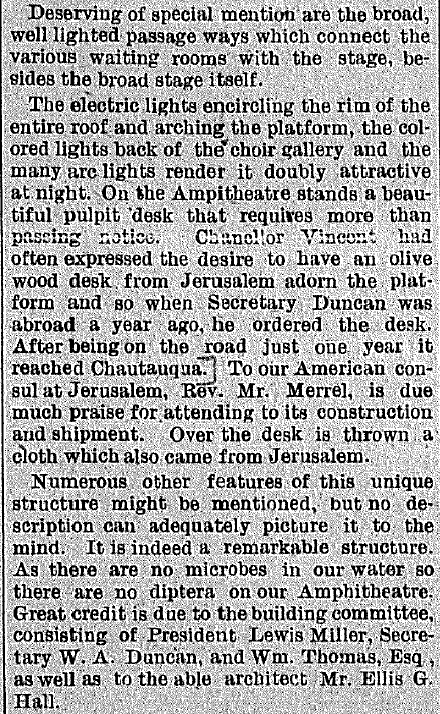 Editors Note: I hope you noticed above that the first podium on the new 1893 platform was an olive wood desk imported from Jerusalem.
Editors Note: I hope you noticed above that the first podium on the new 1893 platform was an olive wood desk imported from Jerusalem.
Who knew – Hires’ Root Beer is advertised as a Temperance Drink. Cleverly, Hires’ Mad Men changed the copy to expertly target the Chautauqua Assembly demographic. “This great home-made temperance drink is as healthful as it is pleasant. It keeps the children cool and happy. Lightens the cares of the parents and gives new life to the old folks. It’s a real home comfort.”
“The cost of the Amphitheatre was a trifle under$25,000 (actually it came in over $26K as the new electric lighting ran over budget). It was a great work to finish this building in time for the opening exercises, but by working day and night it was done. A week before the season opened almost everyone said it could not be ready, but Chautauqua never yet failed to do what she promised and it had to be completed.”
From the August 2, 1893 Chautauqua Assembly Herald covering the Opening Ceremonies Editor Dr. Flood writes:
“Opening Day at Chautauqua is ever a glad day. It bears in its open palm the bright prophecy of coming days. it comes with glad greetings. It revives old friendships. It awakens old happy memories. Its bells thrill the pulses of these groves with a new life. It is the launching of another ship in a growing navy. It is not a carnival but a re-dedication. It is the uncovering of the coals of the Chautauqua spirit, it is a rekindling of slumbering enthusiasm, a relighting of refilled torches.”
The Assembly Herald printed the speeches word for word as President Miller went on to officially open the Assembly followed by Dr. Hurlbut who harkened back to the First Assembly:
“I have been looking back tonight and trying to put myself in the condition of those people who did come to the first Assembly. in those day there was a tabernacle of slabs on top of the hill, and we sat on benches made of slabs and ate off a table of slabs, slabs of things that we never knew what they were, and we were glad to get them. And we did not sit in an Amphitheatre like this. I remember one occasion it began to rain. People did not get up and leave when it began to rain in those days, they simply raised their umbrellas. Chautauqua has gone on. It has sent its influence wherever the waves of the ocean roll.”
Dr. W.R. Harper followed Dr. Hurlbut to the Podium on the Platform and his words proved timeless and so very appropriate today, in light of the burgeoning controversy surrounding the proposed plans for building another New Amphitheater. Don’t you just love it when someone else says it better than you ever could have.
“Ladies and Gentleman: – At this time it becomes us to look back and at the same time to look forward. Has the time come for Chautauqua to stand still? No. The lesson of the past is clear. Chautauqua must do in the future what she has done in the past…My faith in Chautauqua is dependent upon doing one thing. The cultivation of these friends and lovers of Chautauqua …of criticism. Not higher criticism but Chautauqua criticism… Criticism is the use of opportunities with that which is to be criticised in such a way that its great purpose and the means it has developed to carry out that purpose shall be known to those who are friendly toward it…Not the criticism that will pick out this flaw and that flaw, but criticism that will point out the grandeur of the work and point out its possibilities… what can be done, what ought to be done. And so will not the friends of Chautauqua familiarize themselves more closely than ever with what Chautauqua plans today. Will you not be ready for the announcement of new plans in the future? For if Chautauqua is to do for the future what she has done for the past, it must present new plans. And when they are announced will you not study them, will you not lay them upon your heart and soul, will you not help Chautauqua do for others what she has done for you.”
(Applause)

